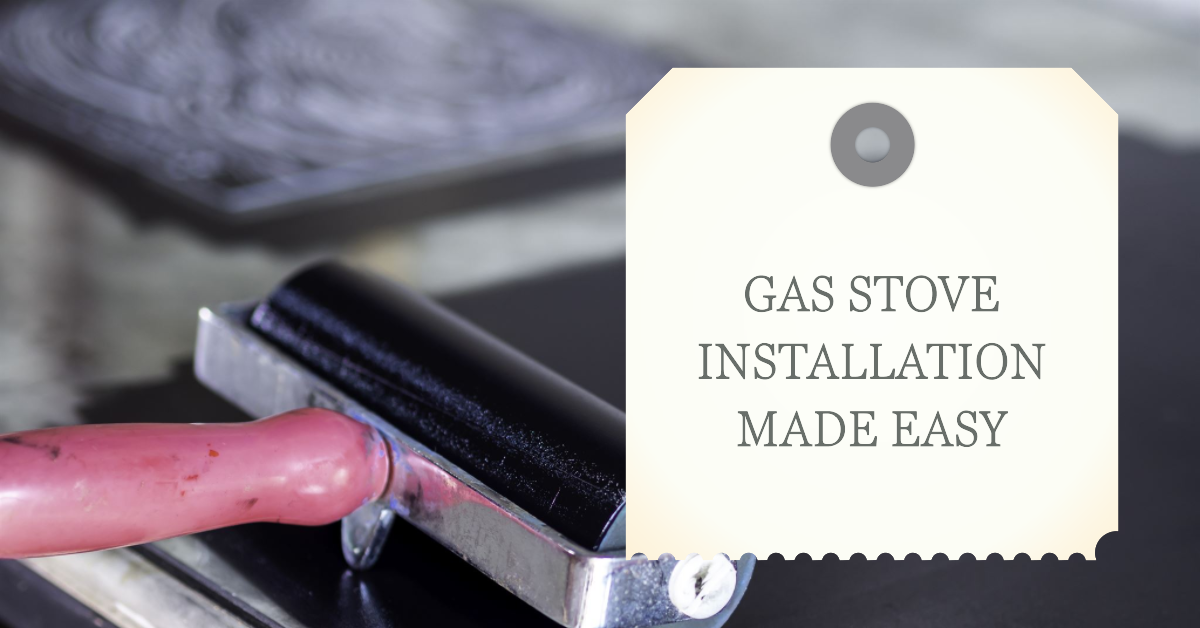Installing a gas stove can be a rewarding home improvement project that enhances your cooking experience and adds value to your kitchen.
However, it’s crucial to approach this task with utmost care and follow proper guidelines to ensure safety and efficiency.
In this comprehensive guide, we will walk you through each step of the gas stove installation process, empowering you to confidently complete the task without the need for external assistance.
Mastering the Art of Gas Stove Installation: A Comprehensive Guide
Before You Begin:
- Safety First: Safety should be your top priority when working with gas appliances. Always turn off the gas supply and disconnect the power before starting the installation process. Additionally, wear safety goggles and gloves to protect yourself from potential hazards.
- Gather the Tools: Before you begin, ensure you have all the necessary tools at hand. These may include an adjustable wrench, pipe wrench, pipe thread sealant, gas line shut-off valve, flexible gas line, and a gas leak detector. Having all the required tools within reach will help you maintain a smooth installation process.
- Check Local Regulations: Gas installations are subject to local building codes and regulations. It’s essential to research and understand these guidelines to ensure your gas stove installation complies with safety standards and legal requirements.
Step-by-Step Gas Stove Installation Guide:
Step 1: Choose the Right Location:
Selecting an appropriate location for your gas stove is vital for both safety and functionality. Ideally, place the stove near the existing gas supply line to minimize the need for extensive piping. Ensure there is adequate ventilation in the area to allow for proper combustion and the release of any fumes or odors.
Keep in mind that installing the gas stove too close to windows or doors may cause drafts that affect the stove’s performance. Avoid placing the stove near flammable materials such as curtains or cabinets. It’s also essential to consider the proximity of doors and windows to prevent drafts that may interfere with gas combustion.
Step 2: Prepare the Area:
Clear the designated space and remove any obstacles that might hinder the installation process. Ensure the floor is level, as an uneven surface can cause stability issues and uneven cooking.
Clean the surface where the stove will sit to remove dust and debris. A clean and level surface ensures that the stove sits securely and operates efficiently. Additionally, consider placing a protective sheet or floor mat underneath the stove to catch any spills or debris during cooking, making cleanup easier.
Step 3: Install the Gas Line Shut-Off Valve:
Before connecting the gas line, install a gas line shut-off valve near the stove location if one is not already present. The shut-off valve allows you to quickly and safely turn off the gas supply to the stove in case of an emergency or when it’s not in use.
To install the shut-off valve, turn off the main gas supply and carefully follow the manufacturer’s instructions. It’s essential to use appropriate tools and materials for a secure installation. Once installed, label the shut-off valve for easy identification in case of an emergency.
Step 4: Connect the Gas Line:
Now it’s time to connect the flexible gas line to the shut-off valve on one end and the gas inlet of the stove on the other end. Most gas stoves come with a flexible connector, but if not, you can purchase one that fits your stove model.
Before connecting, apply pipe thread sealant to the threaded connections to ensure a gas-tight fit and prevent gas leaks. Be cautious not to overtighten the connections to avoid damaging the threads.
When connecting the gas line, make sure the flexible gas hose is free of kinks and bends to ensure a smooth and consistent gas flow. Position the hose in a way that doesn’t interfere with the stove’s placement or movement.
Step 5: Test for Gas Leaks:
Before turning on the gas supply, it is essential to conduct a thorough gas leak test to ensure there are no leaks in the connections. Gas leaks can be hazardous and must be addressed immediately.
To perform the gas leak test, apply a gas leak detector solution or a mixture of soapy water to all connections and joints. If you notice bubbles forming, there is a gas leak, and you should rectify the issue before proceeding. In such cases, disconnect the gas line, reapply the pipe thread sealant, and retest until there are no leaks.
Step 6: Position and Secure the Gas Stove:
Carefully slide the gas stove into its designated spot. If the floor is not level, adjust the stove’s adjustable legs to ensure it sits evenly. An unstable stove can be dangerous and may lead to accidents.
To prevent accidental tipping, anchor the stove to the floor or wall using anti-tip brackets. Most modern stoves come with anti-tip mechanisms, but if your stove doesn’t have them, consider purchasing and installing them separately.
Step 7: Connect the Power (If Applicable):
If your gas stove has electronic ignition or requires electricity for other features, ensure the power supply is safely connected. Use the appropriate electrical outlets and cords, following the manufacturer’s instructions.
Before proceeding, double-check that the gas shut-off valve is open and all gas and electrical connections are secure.
Step 8: Final Checks:
Before using your newly installed gas stove, perform a final inspection to ensure everything is in order. Double-check all connections, verify that the gas shut-off valve is open, and ensure proper ventilation.
Test the stove’s burners and oven to ensure they ignite correctly and produce a steady flame. Confirm that all knobs and controls are functioning as intended. If your stove features electronic ignition, ensure that it is working correctly.
Additionally, read the manufacturer’s manual and familiarize yourself with the stove’s features and safety instructions. Understanding how to properly operate and maintain your gas stove will ensure longevity and safe usage.
Final Words:
By following this comprehensive step-by-step guide, you can confidently install your gas stove with safety and efficiency in mind. Prioritize safety at every stage, adhere to local regulations, and perform thorough checks to prevent any potential hazards.
A properly installed gas stove not only enhances your cooking experience but also contributes to the overall aesthetics and functionality of your kitchen. If you ever feel uncertain about any step in the process, don’t hesitate to seek professional assistance.
With your gas stove installed correctly, you can now cook with confidence, knowing that your kitchen is equipped with a reliable and safe appliance. Enjoy the culinary delights that your new gas stove brings, and remember to share your cooking experiences with friends and family. Happy cooking!

